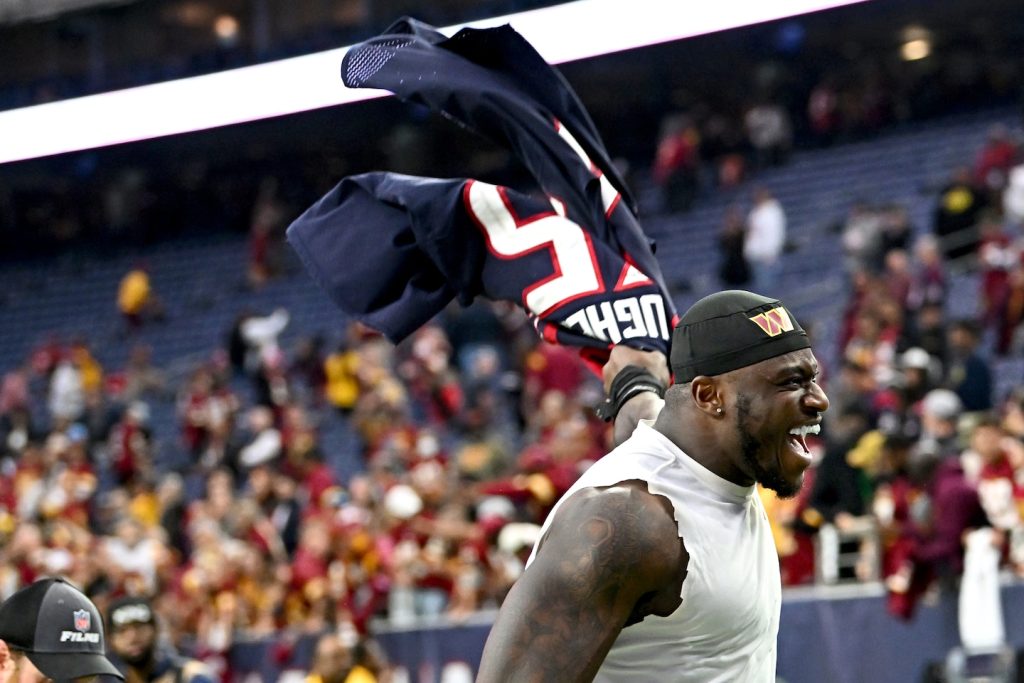But that afternoon in November, some teammates celebrated the draw by teasing defensive end Efe Obada, who was born in Nigeria and raised in England. Defensive linemen Jonathan Allen and Casey Toohill were reportedly among the players who spent the day chanting, “U-S-A! U-S-A!”
“They’re like, ‘Oh, it’s our fifth sport! Imagine if we cared about [soccer]!’” Obada said.
“Just like the Americans,” defensive tackle David Bada, who was born and raised in Germany, said. If the U.S. had actually won, he joked, Allen and Toohill might’ve draped the whole building in American flags.
Despite the old joke — that soccer is America’s sport of the future and always will be — a growing body of evidence suggests the sport is gaining momentum here. Data points include attendance, TV ratings, U.S.-born players abroad and even the popularity of the TV show “Ted Lasso” and the touring podcast “Men in Blazers.” The U.S. was one of the leading countries in ticket sales for this year’s World Cup, according to a FIFA official, and it will jointly host the next one in 2026 with Canada and Mexico. (Concerns about FedEx Field helped torpedo Washington’s bid to be one of the 16 host cities. Instead, 11 other NFL stadiums will host the games in the U.S.)
The Commanders might seem positioned be at the forefront of the NFL’s embrace of soccer. They play in one of the nation’s most avid soccer markets and have an international roster. Team president Jason Wright is a Liverpool fan. And this season, the Commanders have leaned into the local soccer scene. In training camp, the Washington Spirit of the National Women’s Soccer League visited practice and had a field-goal kicking competition with kicker Joey Slye and punter Tress Way. In October, the team hosted D.C. United, including Coach Wayne Rooney, a former star player in England.
But Bada and Obada were among the few players on the team who recognized Rooney, which Bada considered “mind-blowing.”
“I don’t know basketball a lot, but I know a couple players, like, at least the big players: LeBron James, Michael Jordan,” he said. “But they know nothing about soccer. It’s crazy.”
During D.C. United’s visit, the team gave star receiver Terry McLaurin a jersey. He appreciated the gesture but hasn’t started following soccer beyond occasionally playing FIFA, the soccer video game. He said he hadn’t watched one game of the World Cup and never played soccer growing up.
“Too much running,” McLaurin said. “I really don’t like running too much when I don’t have to.”
One of the only U.S.-born players on the Commanders who loves soccer is offensive lineman Saahdiq Charles. As a kid, he enjoyed it because, unlike his youth football league, soccer didn’t have a weight limit to touch the ball. Charles played forward and goalie on a travel team until high school. But then his football prospects brightened, and his mother encouraged him to focus on the more lucrative option.
A reporter asked Charles if he ever wished he stuck with soccer. Charles gave an incredulous look. The 23-year-old, who’s in the third year of a four-year rookie contract, has a base salary ($895,000) that is more than double the base salary for a senior Major League Soccer player ($438,728).
Though Charles doesn’t watch soccer as much as he used to — he once followed the English Premier League, La Liga and the Champions League — he still plays FIFA and regularly checks in on his favorite players, including Kylian Mbappé and Cristiano Ronaldo. He’s caught a few World Cup games, including a scoreless draw between Mexico and Poland and a 1-1 draw between the U.S. and Wales.
“USA should’ve clapped Wales,” he noted. “They suck.”
The closest thing to a soccer nerve-center in the locker room is a bank of stalls in a far corner, where Slye, Obada and Bada have chatted this season. In September, Slye scoffed at Obada’s favorite player (Ronaldo) and said he preferred the Brazilian legend Ronaldinho. Obada accused Slye of not supporting a player only because everyone else does, and Slye countered that Ronaldo is selfish — and that, with Manchester United, he was “doo-doo.”
One day, when Obada was explaining his soccer fandom — Nigeria first, England second — Slye piped up: “Who’s your favorite non-I-was-born-and-raised-there team?”
“Whatever football team pays me,” Obada quipped.
During the early stages of the tournament, Bada mostly watched the games at home or on his phone in the facility. But for Germany’s second game — a 1-1 draw with Spain — he went to a bar with some friends from the German military who are stationed in the U.S.
Last Thursday, Bada was sitting at his locker, watching Germany wallop Costa Rica, when he turned over to the game between Japan and Spain. He saw Japan was winning, which would knock Germany out of the tournament, and yelled, “No way!”
By the next week, Germany and the United States both had been eliminated, and Obada was the only player in the locker room whose team had survived. When asked if he’d get after his teammates as they’d done to him, he just grinned.

